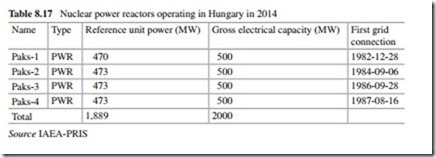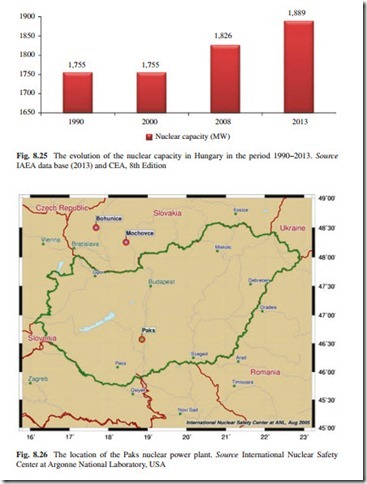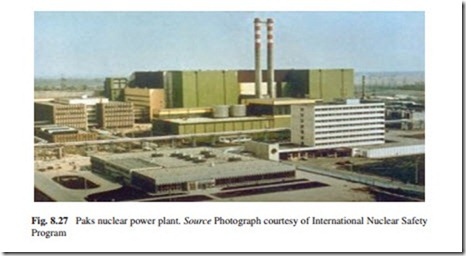Hungary
According to the IAEA, Hungary has four WWER units of Soviet design with a total net capacity of 1,889 MW built during the period 1982–1987 and all located on Paks nuclear power plant site, about 5 km South of the town of Paks, on the right bank of the Danube River. The original design lifetime is for 30 years. In Table 8.17, information about these units is included.
The evolution of the nuclear capacity of the Paks nuclear power plant during the period 1990–2013 is shown in Fig. 8.25.
The location of the Paks nuclear power plant is included in Fig. 8.26. Paks nuclear power plant is shown in Fig.8.27.
Continuous upgrading of the plant has resulted in good production and safety indicators. In 1996–2002, several important safety improvement measures were taken (for a total budget of about US$300 million):
• Emergency and accident management improvement;
• Increased reliability of safety systems;
• Decreased equipment usage;
• Supporting of operational staff;
• Improved earthquake protection;
• Improved fire safety;
• Reconstruction of the reactor protection system;
• Installation of the unit and back-up control room’s emergency iodine filtering system;
• Vibration absorber under the steam generator;
• Strengthening of the walls around the I&C equipment;
• Supporting bridge of the localization towers (OECD 2012).
Another key measure for long-term operation of the Paks nuclear power plant is the implementation of severe accident management. The implementation period for this program is 2011–2014, and the total budget is about €100 million and it includes the following:
• Installation of passive autocatalytic hydrogen recombines into the containment to preserve the integrity of the containment. The required installed capacity has been identified, which is sufficient for neutralization of the generated hydrogen volume;
• Construction of a reactor cavity flooding system with external cooling of the reactor vessel, which aims at preventing interaction of the corium with the concrete in the event of a severe accident. Reactor vessel cooling is necessary to avoid corium escaping from the reactor vessel;
• Reinforcement of the spent fuel pool pipelines and installation of quick action valves to mitigate the risk of emptying the spent fuel pool;
• Installation of accident monitoring system;
• Autonomous power supply for the safety valves of the pressurizer (OECD 2012).
Energy Policy and Strategic Goals
According to Morales Pedraza (2012), the Hungarian authorities adopted, in 1994, a new energy policy in order to take into account the new political and economic situation existent in the country after the collapse of the former Soviet Union and the disappearances of the European socialist group. The main strategic goals of the Hungarian energy policy are the following:
• Exemption of the unilateral import dependency of the country;
• Restraint of the environmental damages of energetic;
• Helping of thrift and more efficient and consuming model;
• Extension of social acceptance system;
• Flexible development system;
• Creating of the development sources (capital investment).
The main goals of the Hungarian energy policy directives approved by the parliament are the following:
• Maintaining and increasing energy supply stability;
• Increasing energy efficiency and the role of energy conservation, thereby improving the competitiveness of the Hungarian economy;
• Establishing a market conforming organizational, economic, and legal background;
• Enforcing environmental protection aspects;
• Promoting European integration in the energy sector.
Since its approval in 1993, certain parts of the directives and strategic objectives have already been implemented, while others are currently underway. These objectives are the following:
• Increase storage capacity for oil;
• The construction of a new gas transmission pipeline between Austria and Hungary;
• The plan for building secondary reserve capacity for the connection to the Hungarian electrical grid with the electric energy system of Western Europe.
Electricity Generation Using Nuclear Energy
In 2007, the nuclear net electricity generation was 13.9 TWh representing 37 % of the total electricity generation in the country in that year, which was a little bit over 35 TWh. In 2008, the nuclear share was 37.15 %. In 2013, the generation of electricity using nuclear energy represented 50.71 % of the total electricity generated in the country in that year (see Table 8.18). This represents an increase of 13.71 % with respect to 2007.
It is important to highlight that nuclear power provides electricity to the Hungarian’s population at the lowest cost considering all energy options available in the country and this situation is expected to continue in the future.
According to the Hungarian energy policy, it is expected that nuclear energy continues playing an important role in the energy mix of the country during the coming years. For this reason, the government has decided to expand the nuclear power plant in Paks in order to build two new units in the coming years. Russia will provide these new units.
For this reason, the government has decided to expand the nuclear power plant in Paks in order to build two new units in the coming years. Russia will provide these new units.
Finally, it is important to highlight the following: The complementary safety review after the Fukushima Daiichi nuclear accident concluded that the four units at the Paks nuclear power plant are satisfactorily protects against key events and no immediate measures are needed. However, some improvements have been suggested, especially:
• Improved protection against external events;
• Amendment of existing plant procedures;
• Provision of existing and alternative electrical power supplies;
• Provision of existing and alternative cooling;
• Mitigation of the consequences of severe accidents.
The total cost of these corrective actions is about €80–150 million, for all four units. These corrective actions will be implemented during 2012–2017. The total cost of the long-term operation program (2011–2020) for all four units of the Paks nuclear power plant is thus projected to be between €1,010 and
€1,080 million. The effect of Fukushima Daiichi nuclear accident on the longterm operation program of Paks nuclear power plant represents between 10 and 17 % increase of initially planned investment. The specific investment costs for the Paks nuclear power plant long-term operation program are thus US$740– US$792 per kWe. This is considerably smaller than the investment needed to build an alternative capacity, for which the specific overnight costs are given as follows:
• Approximately US$1,100 per kWe for a CCGT plant;
• About US$1,940 per kWe for a lignite plant;
• US$5,195 per kWe for a new nuclear power plant (OECD 2012).
The operational and maintenance costs are expected to decrease by about 10 % after the refurbishment, and the fuel costs are assumed to remain the same as before the refurbishment. It is assumed that the original investment in construction is already paid off, and no other costs should be included.
The Public Opinion
According to Morales Pedraza (2012), it is important to highlight that the public opinion in Hungary supports, in general, the use of nuclear energy for electricity generation, as we can infer from a vote that took place in the municipality of Bátaapáti, South of the Paks nuclear power plant in July 2005. According to this survey, the residents of the municipality voted overwhelmingly to approve the construction of the country’s final repository for low- and intermediate-level radioactive waste in the in the South- Central region of Hungary (voting turnout of 75 %, residents voted 90.7 % in favor of having the repository built at municipal plant in the area). Moreover, the results of the Eurobarometer on radioactive waste published in June 2005 show that Hungary is the country with the biggest share of citizens who support nuclear power (65 %).
Looking Forward
In the 1980s, the government planned to construct two VVER-1000 units (Units 5 and 6 of 950 MWe net of capacity) at Paks nuclear power plant site. Preparations were almost completed when the project was canceled in 1989 due to decreased power demand. In 1996–97, Paks nuclear power plant owner proposed once again building a further one or two units of 600–700 MW capacity—the WESTINGHOUSE AP 600 design, the AECL CANDU-6 or the ATOMSTROYEXPORT/SIEMENS VVER-640.
The proposals were rejected because it did not fit government policy at that time and the preliminary environmental impact study was not completed. According to an explanation set out in the resolution approved by lawmakers, “preparations towards making the investment in the new unit will take at least five years to complete.” The commissioning, planning, and implementation of the construction project are expected to take a minimum of six years. Therefore, the overall period leading to construction will be at least 11 years. The explanation in the resolution stated that “some 73 % of Hungarians support nuclear power generation in the country.” Parliamentary approval was required before any discussions could begin on specific issues such as the reactor design. However, the government has confirmed that between 2,000 and 6,000 MW of new nuclear-generating capacity was needed at the Paks site in the future.
With the need to build about 6,000 MWe of new generating capacity by 2030 in order to satisfy the foreseeable increase in the electricity demand, new nuclear plant was again considered, and two 1,000 MW units for the Paks site are pro- posed. In March 2009, the Hungarian parliament by a vote of 330 in favor, 6 against and 10 abstentions gave preliminary approval to this proposal, though some foreign investment would be needed. Paks nuclear power plant owner expected to issue an invitation to tender in 2012, with a decision in 2013 and was considering five PWR reactor types: AREVA’s EPR; the AREVA-MITSUBISHI Atmea1; ATOMSTROYEXPORT’S VVER-1000 or -1200; the WESTINGHOUSE AP10003;
and Korea’s APR-1400. It was not keen on first-of-a-kind designs and hoped to avoid the need for cooling towers. Newer units should be capable of load-following.
Rather than proceeding with open tender, in January 2014, the government signed an agreement with ROSATOM to build two reactors at Paks, with Russia providing 80 % of the finance. The government said that the EU had already approved a draft plan for building the units of up to 1,200 MW each, at a likely cost of around €12 billion (see Table 8.19). The first unit is to be operational about 2023. They will be under the Hungarian state ownership, probably through MVM Paks Nuclear Power Plant Ltd or MVM Paks II, the project company set up to carry out the new project. The fuel is to be supplied by Russia. A €10 billion financing deal from Russia was agreed in February to cover 80 % of the antici- pated project cost, with Hungary to repay the loan over 21 years of operation. The interest rate is below 4 % for 11 years and then goes up to 4.5 % and then up to 4.95 %. In a 256-29 vote the parliament approved the finance deal.
Beyond Paks Units 5 and 6, consideration of future options for Hungary involves the so-called “VISEGRAD 4”: Poland, Slovakia, the Czech Republic and Hungary, which are cooperating closely on nuclear power issues, including in research into future reactor designs and infrastructure development. A nuclear cooperation agreement with the Republic of Korea was signed in October 2013.
On a long-term basis, nuclear power and to a limited extend domestic coal are the only two energy alternatives for electricity supply in Hungary. Taking into account that there is no referendum or governmental or parliamentary decision to stop using nuclear energy for electricity generation in the future, and bearing in mind that the public opinion is, in general, in favor of continuing using nuclear energy for electricity generation, the future of the nuclear power program in Hungary is assured, leaving the door open to the construction of new nuclear power reactors in the future, if necessary in order to satisfy any foresee increase in the energy demand.
In addition, and in order to continue the use of nuclear energy for the generation of electricity in the country in the coming years, the Hungary’s National Atomic Energy Office has issued a license to extend the operating life of Unit 2 of the Paks nuclear power plant by 20 years until December 31, 2034. Unit 1 was granted a similar license in 2012.
Plant operator MVM Paksi Atomeromu, which is owned by state energy holding company MVM, said in a statement that it expects to receive extensions to the operating licenses of Units 3 and 4, which expire in 2016 and 2017, respectively.
In early 2014, Hungary and Russia signed a cooperation agreement which included the construction of two new VVER reactors of up to 1,200 MWe each at Paks nuclear power plant site. The first new unit is to be commissioned in 2023, with the second following about two years later.
In August, used fuel assemblies that were damaged during a chemical cleaning process at the plant in 2003 were transported to Russia for processing. Irradiated fuel from Unit 2 of the Paks nuclear power plant suffered damage from overheating in April 2003 when water circulation in a nuclear fuel washing tank was inadequate. The assemblies overheated in the cleaning tank, which was submerged in the transfer pond, so that most became deformed with burst cladding, releasing radioactive material into the water, and noble gases into the plant area. The clean- ing tank was designed, manufactured, and operated by France’s FRAMATOME ANP. The event was categorized as Level 3 on the IAEA International Nuclear Events Scale. Unit 2 was shutdown at the time its fuel was removed for washing and did not restarted until December 2006 due to the complications posed by the stranded damaged fuel. Russia’s TVEL won an international tender for restoration work at Unit 2. The removal of the damaged fuel was completed in January 2007.
Finally, it is important to highlight the following: Russia and Hungary’s nuclear regulators signed in December 2014 an agreement to cooperate on nuclear energy and nuclear safety. Russia’s ROSTECHNADZOR said in a statement that the agreement to cooperate in nuclear and radiation safety in the use of nuclear energy for peaceful purposes is an updated version of a similar document signed with the Hungarian Atomic Energy Authority (HAEA) in 2001 that reflects administra- tive changes at the two authorities. According to World Nuclear News, the agreement was signed by Alexy Aleshin, the head of ROSTECHNADZOR, and Gyula Fichtinger, HAEA director-general. “I believe that the signing of this agreement is not only an important step in the development of bilateral cooperation between the regulators of Hungary and Russia, but that it will also strengthen bilateral relations between our countries,” Aleshin said.
New areas of cooperation include sharing lessons learned from the Fukushima Daiichi nuclear accident. They will also exchange experience in the licensing and supervision of the safe use of nuclear energy. In addition, the agreement provides for new areas of cooperation, such as emergency preparedness and response, as well as the training of staff.




